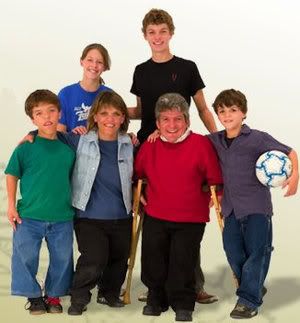1) Achondroplasia- characterized by abnormal bone growth that results in short stature with disproportionately short arms and legs, a large head, and characteristic facial features with frontal bossing and mid-face hypoplasia. Intelligence and life span are usually normal, although compression of the spinal cord and/or upper airway obstruction increases the risk of death in infancy.http://www.geneclinics.org/profiles/achondroplasia/details.html Clinical Diagnosis
The clinical features of achondroplasia include the following:
Short stature
Rhizomelic (proximal) shortening of the arms and legs with redundant skin folds on limbs
Limitation of elbow extension
Trident configuration of the hands
Genu varum (bow legs)
Thoracolumbar gibbus in infancy
Exaggerated lumbar lordosis, which develops when walking begins
Large head with frontal bossing
Midface hypoplasia
FGFR3 is the only gene known to be associated with achondroplasia.
Treatment: Suboccipital decompression.

 2)Alzheimers Disease
2)Alzheimers DiseaseIs a progressive and fatal brain disease
Symptoms:
Memory changes that disrupt daily life
Challenges in planning or solving problems
Difficulty completing familiar tasks at home, at work or at leisure
Confusion with time or place
Trouble understanding visual images and spatial relationships
New problems with words in speaking or writing
Misplacing things and losing the ability to retrace steps
Decreased or poor judgment
Withdrawal from work or social activities
Changes in mood and personality
Gene: Alzheimers is found on the APOE-e4 gene. Everyone inherits a copy of some form of APOE from each parent. Those who inherit one copy of APOE-e4 have an increased risk of developing Alzheimer’s
http://www.alz.org/alzheimers_disease_causes_risk_factors.asp
The Society's Black and Minority Ethnic Communities Project was set up to increase our understanding and to share our knowledge of dementia by working in partnership with people from the black and minority ethnic communities in London
http://alzheimers.org.uk/site/scripts/documents_info.php?documentID=412
There is no cure for alzheimers at the moment

 3) Anemia
3) Anemiadescribes the condition in which the number of red blood cells in the blood is low. For this reason, doctors sometimes describe someone with anemia as having a low blood count
Symptoms:
Fatigue
weakness
shortness of breath
lightheadedness
palpitations (feeling of the heart racing or beating irregularly)
looking pale
abnormal hemoglobin molecules is the cause of Anemia
Treatment:
iron supplements
fluids
blood transfusion
oxygen








